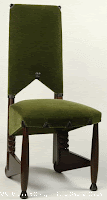
Recently, an artist's retrospect broke all opening night attendance records at the Pennsylvania Academy of Fine Arts. That artist was Henry Ossawa Tanner (1859-1937).
Tanner was the child of African Methodist Church Bishop Benjamin Tanner
 and the former slave Sarah Tanner, came North via the Underground Railroad.
and the former slave Sarah Tanner, came North via the Underground Railroad.By age 13, Tanner was completely smitten with the idea of becoming an artist. His father could not discourage him of the idea. His talent was such that at age 19, he was accepted to Pennsylvania Academy of Fine Arts. (Right: Tanner's bust of his father.)
Tanner was well regarded by his teachers for his skills. However, this slight somewhat frail black man suffered immeasurably from other students as the only African-American. In his words:
I was extremely timid and to be made to feel that I was not wanted, ... caused me sometimes weeks of pain. Every time any one of these disagreeable incidents came into my mind, my heart sank, and I was anew tortured by the thought of what I had endured, almost as much as the incident itself.
In spite of all the cruelty directed at Tanner, he completed his studies and gained a reputation as an excep
 tional painter, photographer and sculptor. It should have been enough, but this was after the Civil War and the Supreme Court's "separate but equal" ruling.
tional painter, photographer and sculptor. It should have been enough, but this was after the Civil War and the Supreme Court's "separate but equal" ruling.Tanner was frustrated at being described as a "Negro painter." Even when sympathetic patrons arranged an exhibit for him, he could not sell his art. Tanner decided to go abroad to further his training.
Being a man of courage and fortitude, Tanner raised the money to go to Paris. There, he studied the Masters and flourished as an artist. Europeans did not confuse his talent with his race. Tanner was able to create and thrive in that environment.

Today as the history of brave and determined blacks is noted during Black History Month, let's give a shout out to this extraordinary pioneer.
Here are some of his paintings: (click image to enlarge)

































